Sundar Aditya
Channel Coding meets Sequence Design via Machine Learning for Integrated Sensing and Communications
Mar 29, 2025Abstract:For integrated sensing and communications, an intriguing question is whether information-bearing channel-coded signals can be reused for sensing - specifically ranging. This question forces the hitherto non-overlapping fields of channel coding (communications) and sequence design (sensing) to intersect by motivating the design of error-correcting codes that have good autocorrelation properties. In this letter, we demonstrate how machine learning (ML) is well-suited for designing such codes, especially for short block lengths. As an example, for rate 1/2 and block length 32, we show that even an unsophisticated ML code has a bit-error rate performance similar to a Polar code with the same parameters, but with autocorrelation sidelobes 24dB lower. While a length-32 Zadoff-Chu (ZC) sequence has zero autocorrelation sidelobes, there are only 16 such sequences and hence, a 1/2 code rate cannot be realized by using ZC sequences as codewords. Hence, ML bridges channel coding and sequence design by trading off an ideal autocorrelation function for a large (i.e., rate-dependent) codebook size.
Rate-Splitting Multiple Access for Integrated Sensing and Communications: A First Experimental Study
Dec 16, 2024Abstract:A canonical use case of Integrated Sensing and Communications (ISAC) in multiple-input multiple-output (MIMO) systems involves a multi-antenna transmitter communicating with $K$ users and sensing targets in its vicinity. For this setup, precoder and multiple access designs are of utmost importance, as the limited transmit power budget must be efficiently directed towards the desired directions (users and targets) to maximize both communications and sensing performance. This problem has been widely investigated analytically under various design choices, in particular (a) whether or not a dedicated sensing signal is needed, and (b) for different MIMO multiple access techniques, such as Space Division Multiple Access (SDMA) and Rate-Splitting Multiple Access (RSMA). However, a conclusive answer on which design choice achieves the best ISAC performance, backed by experimental results, remains elusive. We address this vacuum by experimentally evaluating and comparing RSMA and SDMA for communicating with two users $(K = 2)$ and sensing (ranging) one target. Over three scenarios that are representative of \emph{vehicular} ISAC, covering different levels of inter-user interference and separation/integration between sensing and communications, we show that RSMA without a dedicated sensing signal achieves better ISAC performance -- i.e., higher sum throughput (upto $50\%$ peak throughput gain) for similar radar SNR (between $20$ to $24{\rm dB}$) -- than SDMA with a dedicated sensing signal. This first-ever experimental study of RSMA ISAC demonstrates the feasibility and the superiority of RSMA for future multi-functional wireless systems.
Rate-Splitting Multiple Access for Overloaded Multi-group Multicast: A First Experimental Study
Jun 21, 2024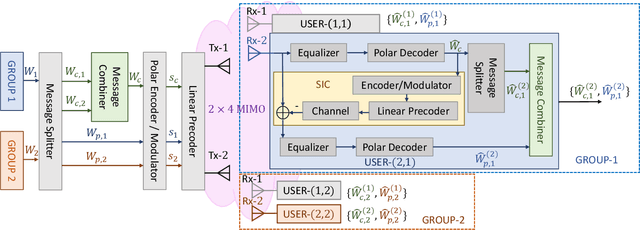
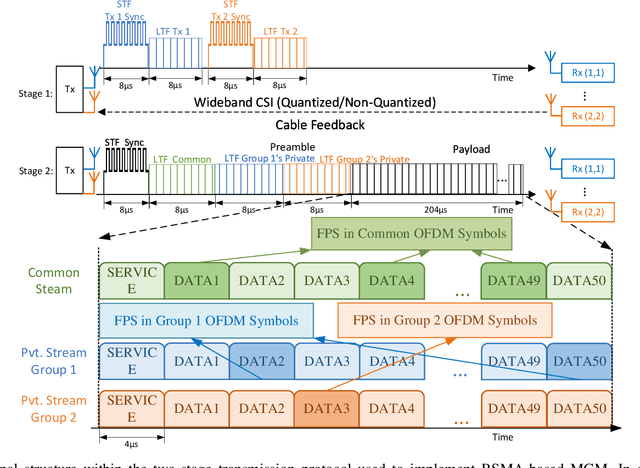
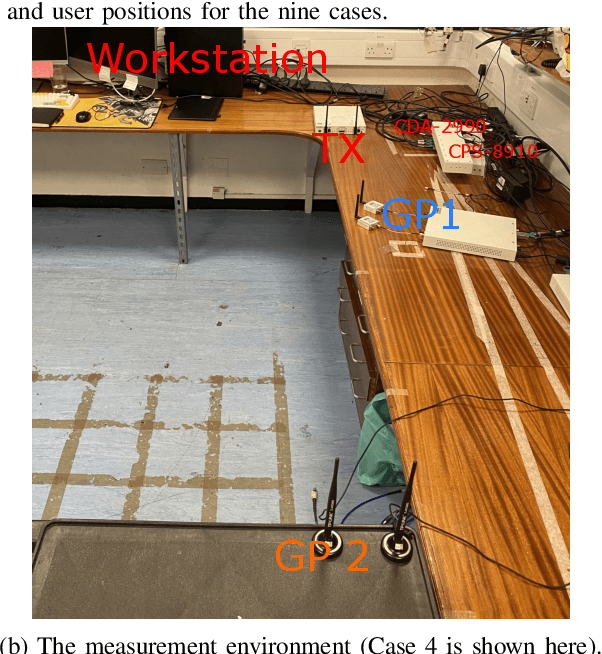
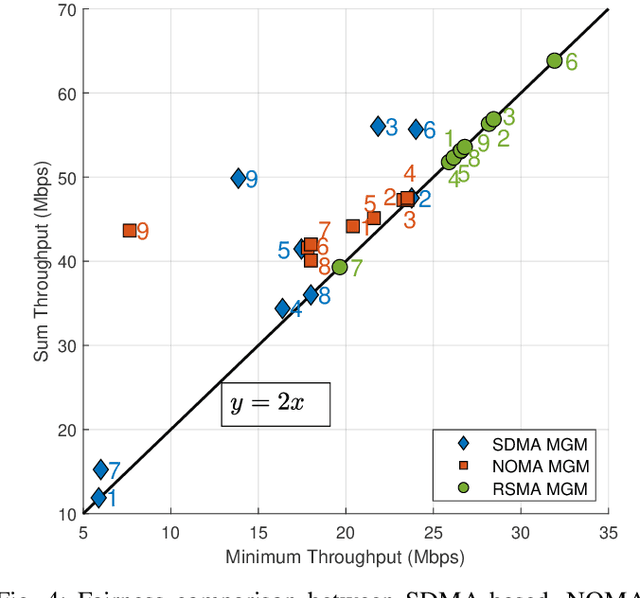
Abstract:Multi-group multicast (MGM) is an increasingly important form of multi-user wireless communications with several potential applications, such as video streaming, federated learning, safety-critical vehicular communications, etc. Rate-Splitting Multiple Access (RSMA) is a powerful interference management technique that can, in principle, achieve higher data rates and greater fairness for all types of multi-user wireless communications, including MGM. This paper presents the first-ever experimental evaluation of RSMA-based MGM, as well as the first-ever three-way comparison of RSMA-based, Space Divison Multiple Access (SDMA)-based and Non-Orthogonal Multiple Access (NOMA)-based MGM. Using a measurement setup involving a two-antenna transmitter and two groups of two single-antenna users per group, we consider the problem of realizing throughput (max-min) fairness across groups for each of three multiple access schemes, over nine experimental cases in a line-of-sight environment capturing varying levels of pathloss difference and channel correlation across the groups. Over these cases, we observe that RSMA-based MGM achieves fairness at a higher throughput for each group than SDMA- and NOMA-based MGM. These findings validate RSMA-based MGM's promised gains from the theoretical literature.
Rate-Splitting Multiple Access for Non-Orthogonal Unicast Multicast: An Experimental Study
Apr 12, 2024Abstract:Non-orthogonal unicast multicast (NOUM) is a variant of multi-antenna multi-user communications where the users desire a shared message (multicast) in addition to their respective unique messages (unicast). The multicast rate is capped in many emerging NOUM applications, such as live-event broadcasting, location-based services and vehicular communications. Given this constraint, we experimentally show that when the user channels are highly correlated, Rate-Splitting Multiple Access (RSMA)-based NOUM can meet the multicast rate while supporting a larger unicast sum rate than conventional multi-user linear precoding (MULP)-based NOUM.
Multi-functional OFDM Signal Design for Integrated Sensing, Communications, and Power Transfer
Oct 31, 2023



Abstract:The wireless domain is witnessing a flourishing of integrated systems, e.g. (a) integrated sensing and communications, and (b) simultaneous wireless information and power transfer, due to their potential to use resources (spectrum, power) judiciously. Inspired by this trend, we investigate integrated sensing, communications and powering (ISCAP), through the design of a wideband OFDM signal to power a sensor while simultaneously performing target-sensing and communication. To characterize the ISCAP performance region, we assume symbols with non-zero mean asymmetric Gaussian distribution (i.e., the input distribution), and optimize its mean and variance at each subcarrier to maximize the harvested power, subject to constraints on the achievable rate (communications) and the average side-to-peak-lobe difference (sensing). The resulting input distribution, through simulations, achieves a larger performance region than that of (i) a symmetric complex Gaussian input distribution with identical mean and variance for the real and imaginary parts, (ii) a zero-mean symmetric complex Gaussian input distribution, and (iii) the superposed power-splitting communication and sensing signal (the coexisting solution). In particular, the optimized input distribution balances the three functions by exhibiting the following features: (a) symbols in subcarriers with strong communication channels have high variance to satisfy the rate constraint, while the other symbols are dominated by the mean, forming a relatively uniform sum of mean and variance across subcarriers for sensing; (b) with looser communication and sensing constraints, large absolute means appear on subcarriers with stronger powering channels for higher harvested power. As a final note, the results highlight the great potential of the co-designed ISCAP system for further efficiency enhancement.
A Prototype Implementation of Rate Splitting Multiple Access using Software-Defined Radios
May 12, 2023Abstract:For interference-limited multi-user communications, many papers have demonstrated, in theory, the effectiveness of Rate Splitting Multiple Access (RSMA) in suppressing the interference and achieving better outcomes (w.r.t spectral efficiency, fairness etc.) than the conventional Space Division Multiple Access (SDMA) used in present-day standards. However, an experimental demonstration of RSMA's benefits is missing in the literature. In this paper, we address this gap by realizing an RSMA prototype using software-defined radios. For the two-user multiple-input single-output (MISO) scenario, we measure the throughput performance of SDMA and RSMA in nine different scenarios that vary in terms of the channel pathloss and spatial correlation experienced by the users. Emulating perfect channel state information (CSI) at the transmitter through unquantized CSI feedback, we observe that RSMA achieves a higher sum throughput (upto 57%) and more fairness than SDMA when the user channels have high spatial correlation. Similarly, emulating imperfect CSI through quantized feedback, RSMA - along with the above trend - also experiences a smaller sum throughput loss, relative to the unquantized case (37%, on average, as opposed to 44% for SDMA). These outcomes are consistent with theoretical predictions, and demonstrate the feasibility and potential of RSMA for next generation wireless networks (e.g., 6G).
Input Distribution Optimization in OFDM Dual-Function Radar-Communication Systems
May 11, 2023Abstract:Orthogonal frequency division multiplexing (OFDM) has been widely adopted in dual-function radar-communication (DFRC) systems, where radar and communications are performed simultaneously with a common signal. However, with random communication symbols (CS) in DFRC, the transmit signal has a random ambiguity function that affects the radar's range-velocity estimation performance, whose influence is remained uncovered. Hence, this paper focuses on minimizing the outlier probability (OP) -- the probability of incorrectly estimating a target's range-velocity bin -- in OFDM DFRC w.r.t the CS probability distribution (i.e., the \emph{input distribution}). Conditioned on the CSs, the OP only depends on the CS magnitudes. Hence, we consider the following two schemes for the above optimization: CSs with (1) constant magnitude (phase shift keying input), and (2) random magnitude (Gaussian input). For (1), the problem reduces to the familiar power allocation design across OFDM's subcarriers and symbols, with uniform power allocation across subcarriers and a \emph{windowed} power allocation across symbols being near-optimal. For (2), the mean and variance of the Gaussian distribution at each subcarrier is optimized, with an additional communication constraint to avoid the zero-variance solution where no CSs are carried. We observe that subcarriers with strong communication channels feature strong variance (i.e., favour communications) while the others are characterized by a strong mean (favouring radar). However, the overall power allocation (i.e., the sum of mean and variance) across the OFDM subcarriers and symbols is similar to (1). Simulations show that CSs with random magnitudes degrade the sensing performance, but can be compensated significantly with the proposed input distribution optimization.
Sensing using Coded Communications Signals
Sep 09, 2022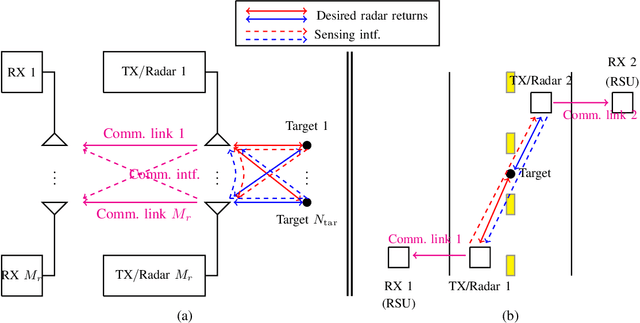


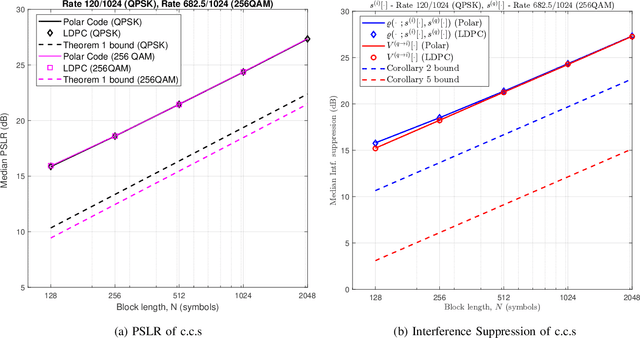
Abstract:A key challenge for a common waveform for Integrated Sensing and Communications (ISAC) - widely seen as an attractive proposition to achieve high performance for both functionalities, while efficiently utilizing available resources -- lies in leveraging information-bearing channel-coded communications signals (c.c.s) for sensing. In this paper, we investigate the sensing performance of c.c.s in (multi-user) interference-limited operation, and show that it is limited by sidelobes in the range-Doppler map, whose form depends on whether the c.c.s modulates a single-carrier or OFDM waveform. While uncoded communications signals -- comprising a block of $N$ i.i.d zero-mean symbols -- give rise to asymptotically (i.e., as $N \rightarrow \infty$) zero sidelobes due to the law of large numbers, it is not obvious that the same holds for c.c.s, as structured channel coding schemes (e.g., linear block codes) induce dependence across codeword symbols. In this paper, we show that c.c.s also give rise to asymptotically zero sidelobes -- for both single-carrier and OFDM waveforms -- by deriving upper bounds for the tail probabilities of the sidelobe magnitudes that decay as $\exp( - O($code rate $\times$ block length$))$. This implies that for any code rate, c.c.s are effective sensing signals that are robust to multi-user interference at sufficiently large block lengths, with negligible difference in performance based on whether they modulate a single-carrier or OFDM waveform. We verify the latter implication through simulations, where we observe the sensing performance (characterized by the detection and false-alarm probabilities) of a QPSK-modulated c.c.s (code rate = 120/1024, block length = 1024 symbols) to match that of a comparable interference-free FMCW waveform even at high interference levels (signal-to-interference ratio of -11dB), for both single-carrier and OFDM waveforms.
 Add to Chrome
Add to Chrome Add to Firefox
Add to Firefox Add to Edge
Add to Edge